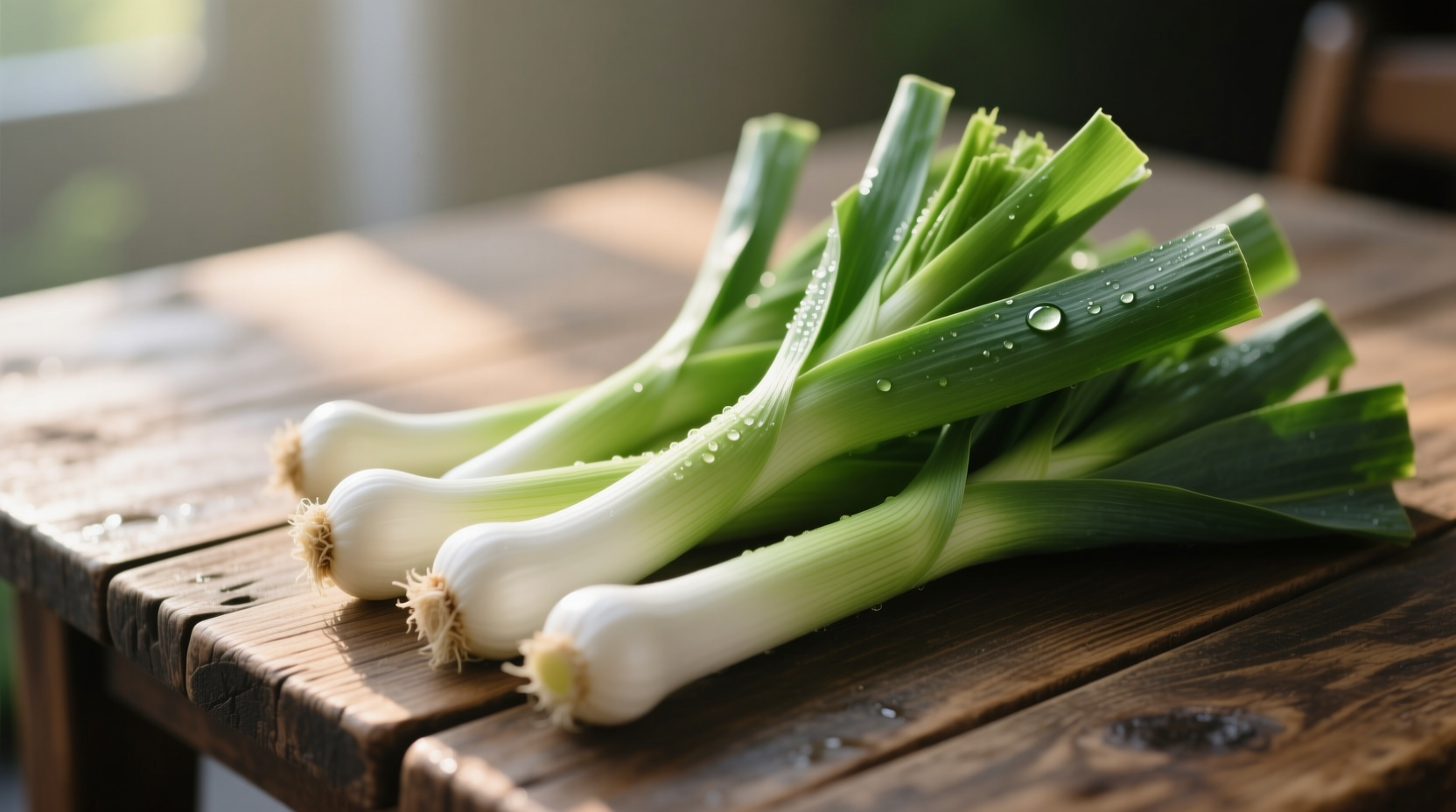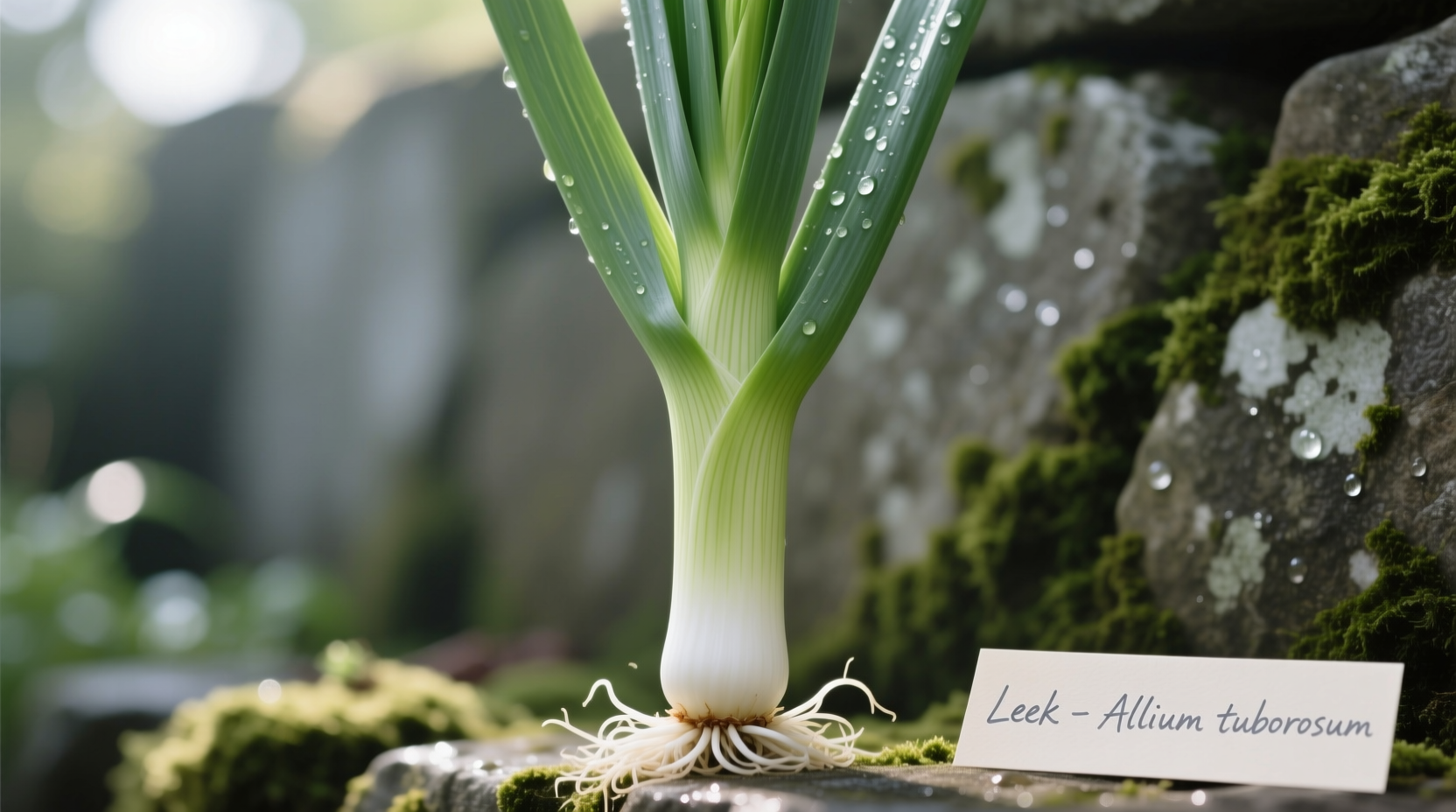A vegetable leek (Allium ampeloprasum var. porrum) is a mild-flavored member of the Allium family that resembles a large scallion, featuring a white bulbous base that transitions into broad green leaves. Unlike onions, leeks don't form a distinct bulb and offer a subtle, sweet onion-like flavor that becomes creamy when cooked properly.
Ever reached for an onion in your kitchen only to find something that looks like an oversized green onion but doesn't quite smell the same? That's likely a leek - nature's gentle alternative to its more pungent Allium cousins. Understanding this versatile vegetable transforms how you approach soups, stews, and elegant dishes that benefit from its delicate flavor profile.
Spotting the Difference: Leek Identification Guide
Leeks often confuse shoppers because they resemble large scallions or small green onions. The key distinguishing features include:
- Structure: No distinct bulb formation (unlike onions)
- Color gradient: Pure white base transitioning through light green to dark green leaves
- Texture: Solid, dense layers rather than separate rings
- Aroma: Mild, sweet scent compared to sharper onion varieties

Leek vs. Similar Alliums: Key Differences
| Vegetable | Structure | Flavor Profile | Common Culinary Uses |
|---|---|---|---|
| Leek | No bulb, cylindrical shape | Mild, sweet, subtle onion flavor | Soups, stews, braises, gratins |
| Onion | Distinct layered bulb | Sharp, pungent, varies by type | Raw applications, caramelizing, roasting |
| Scallion | Small white base, hollow green tops | Moderate sharpness, fresh flavor | Garnishes, stir-fries, salads |
| Shallot | Small clustered bulbs | Sweet, delicate, subtle garlic notes | Vinaigrettes, sauces, fine cooking |
From Ancient Fields to Modern Kitchens: Leek History
Leeks boast a remarkable culinary journey spanning millennia. Historical records show ancient Egyptians valued leeks enough to include them in pharaohs' tombs. Roman emperors like Nero earned the nickname "Porrophagus" (leek eater) for consuming them daily to improve his singing voice. During medieval times, Welsh soldiers wore leeks into battle as identification, establishing the vegetable as Wales' national symbol. Unlike many vegetables that have been significantly altered through selective breeding, modern leeks remain remarkably similar to their ancient counterparts, preserving their distinctive mild flavor profile that chefs continue to prize today.
Nutritional Powerhouse: Health Benefits Worth Noting
While often overshadowed by flashier superfoods, leeks deliver impressive nutritional benefits. A single cup of cooked leeks provides 25% of your daily vitamin K needs, crucial for blood clotting and bone health. They're rich in manganese (15% of daily value), which supports metabolism and bone formation, and contain significant amounts of vitamin B6, folate, and iron. Unlike onions, which can cause digestive discomfort for some people, leeks generally offer a gentler digestive experience while still providing prebiotic fiber that nourishes beneficial gut bacteria. Their antioxidant profile includes kaempferol, associated with reduced inflammation and potential cardiovascular benefits according to research from the USDA Agricultural Research Service.
Shopping Smart: Selecting Quality Leeks
When choosing leeks at your market, look for specimens with crisp, bright green leaves and firm white bases. Avoid any with yellowing leaves, soft spots, or signs of flowering (which indicates age and potential toughness). The ideal leek should feel heavy for its size with tightly packed layers. While larger leeks are more economical, they often contain tougher outer layers that require more preparation. For most home cooking applications, medium-sized leeks (about 1-1.5 inches in diameter) offer the best balance of flavor and tenderness. Remember that leeks continue growing after harvest, so fresher specimens will have more vibrant green tops rather than yellowing foliage.
Mastering Leek Preparation: Avoiding the Dirt Trap
The most common leek mistake? Serving gritty vegetables. Since leeks grow by having soil mounded around their stems, dirt becomes trapped between layers. Proper cleaning requires:
- Cut off root end and dark green tops (save for stock)
- Slice lengthwise through the white base
- Submerge in cold water, separating layers gently
- Swirl to release trapped dirt, then lift leeks out
- Rinse under running water, checking between layers
- Dry thoroughly before cooking
Professional chefs recommend the "water bath" method over running water alone, as the agitation in water more effectively dislodges stubborn soil particles. Never skip the drying step - excess moisture prevents proper caramelization and can make sauces watery.
Culinary Applications: Where Leeks Shine
Leeks excel in applications where you want onion flavor without overwhelming sharpness. Their culinary versatility spans multiple techniques:
- Sweating: Cooked slowly in butter or oil until translucent (never browned) for soup bases
- Braising: Whole small leeks become tender and sweet when cooked in stock
- Gratin: Layered with cream and cheese for elegant side dishes
- Stocks: Dark green tops add depth to vegetable or chicken stocks
- Raw applications: Only the very tender inner white portions work raw in salads
Unlike onions that dominate dishes with their flavor, leeks provide subtle background notes that enhance rather than overpower. They're particularly valuable in dishes where you want aromatic complexity without the sharp bite of raw onions. French cuisine features leeks prominently in vichyssoise (chilled potato-leek soup) and as the foundation for many classic sauces. Their gentle flavor makes them ideal for baby food and dishes for sensitive palates.
Storage Secrets: Maximizing Freshness
Proper storage dramatically extends leek freshness. Keep unwashed leeks in the refrigerator's crisper drawer for up to two weeks. For longer storage, cut leeks into rings, blanch for 2 minutes, then freeze in airtight containers for up to 6 months. Never store leeks near apples or pears, as ethylene gas from these fruits accelerates spoilage. If you notice slight wilting, revive leeks by standing them in cold water for 30 minutes. Cooked leeks maintain quality in the refrigerator for 3-4 days when stored in airtight containers, though their texture softens noticeably upon reheating.
Common Mistakes to Avoid
Even experienced cooks make these leek errors:
- Using the entire leek: Dark green tops are too fibrous for most applications (save for stocks)
- Insufficient cleaning: Results in gritty, unpleasant texture
- Overcooking: Turns leeks mushy rather than tender-crisp
- High-heat cooking: Causes burning before proper flavor development
- Storing with moisture: Accelerates spoilage and sliminess
Professional kitchens often prepare leeks in advance during "mise en place" but store them submerged in water with changed water daily to maintain crispness without accelerating spoilage. This technique works well for home cooks preparing for special occasions.
Perfect Pairings: Flavor Combinations That Work
Leeks harmonize beautifully with specific ingredients that enhance their delicate flavor:
- Dairy: Butter, cream, and soft cheeses like goat cheese
- Herbs: Thyme, parsley, and chives complement without overpowering
- Liquids: Chicken or vegetable stock, dry white wine
- Proteins: Fish, chicken, and eggs create classic French combinations
- Vegetables: Potatoes, carrots, and celery form the "holy trinity" of French mirepoix
Avoid pairing leeks with strongly flavored ingredients like garlic or hot peppers unless you specifically want the leek flavor to play a supporting role. Their subtle nature gets easily overwhelmed by bolder flavors.











 浙公网安备
33010002000092号
浙公网安备
33010002000092号 浙B2-20120091-4
浙B2-20120091-4